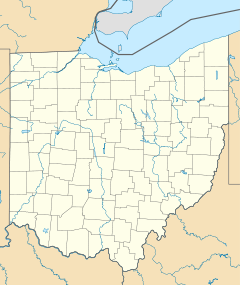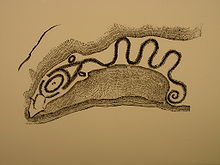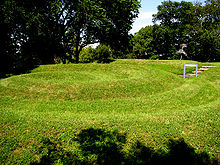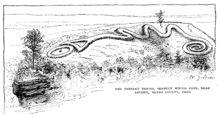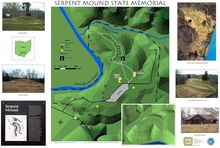- Serpent Mound
-
This article is about the site in the USA. For the one in the UK, see Skelmorlie.Serpent Mound
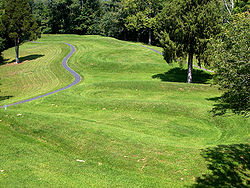 Serpent Mound - an ancient Native American ceremonial structure
Serpent Mound - an ancient Native American ceremonial structureNearest city: Peebles, Ohio Coordinates: 39°1′33.09″N 83°25′49.60″W / 39.0258583°N 83.430444°WCoordinates: 39°1′33.09″N 83°25′49.60″W / 39.0258583°N 83.430444°W Governing body: State NRHP Reference#: 66000602[1] Added to NRHP: October 15, 1966 The Great Serpent Mound is a 1,348-foot (411 m)-long, [2] three-foot-high prehistoric effigy mound located on a plateau of the Serpent Mound crater along Ohio Brush Creek in Adams County, Ohio. Maintained within a park by the Ohio Historical Society, it has been designated a National Historic Landmark by the United States Department of Interior. The Serpent Mound of Ohio was first reported from surveys by Ephraim Squire and Edwin Davis in their historic volume Ancient Monuments of the Mississippi Valley, published in 1848 by the newly founded Smithsonian Museum.
Researchers have attributed construction of the mound to three different prehistoric indigenous cultures. Although it was once thought to be Adena in origin, now based on the use of more advanced technology, including carbon dating and evidence from 1996 studies, many scholars now believe that members of the Fort Ancient culture built it about 1070 CE (plus or minus 70 years). There are still anomalies to be studied.[3] Serpent Mound is the largest serpent effigy in the world.[4]
Contents
Description
 Ohio historical marker
Ohio historical marker
Including all three parts, the Serpent Mound extends about 1,370 feet (420 m), and varies in height from less than a foot to more than three feet (30–100 cm). Conforming to the curve of the land on which it rests, with its head approaching a cliff above a stream, the serpent winds back and forth for more than eight hundred feet and seven coils, and ends in a triple-coiled tail. The serpent head has an open mouth extending around the east end of a 120-foot (37 m)-long hollow oval feature. Scholars posit that the oval feature symbolizes an egg, the sun, the body of a frog, or merely the remnant of a platform. The effigy's extreme western feature is a triangular mound approximately 31.6 feet (9.6 m) at its base and long axis. There are also serpent effigies located in Scotland and Ontario that are very similar.[5]
Origin
The dating of the design, the original construction, and the identity of the builders of the serpent effigy are three questions still debated in the disciplines of social science, including ethnology, archaeology, and anthropology. In addition, contemporary American Indians have an interest in the site. Several attributions have been entered by academic, philosophic, and Native American concerns regarding all three of these unknown factors of when designed, when built, and by whom.
Over the years, scholars have proposed that the mound was built by members of the Adena culture, the Hopewell culture, or the Fort Ancient culture. In the 18th century the missionary John Heckewelder reported that Native Americans of the Lenni Lenape (later Delaware) nation told him the Allegheny people had built the mound, as they lived in the Ohio Valley in an ancient time. Both Lenape and Iroquois legends tell of the Allegheny or Allegewi People, sometimes called Tallegewi. They were said to have lived in the Ohio Valley in a remotely ancient period, believed pre-Adena, i.e., Archaic or pre-Woodland period (before 1200 BCE). Because archaeological evidence suggests that ancient cultures were distinct and separate from more recent historic Native American cultures, academic accounts do not propose the Allegheny Nation built the Serpent Mound.[6]
Radiocarbon dating of charcoal discovered within the mound in the 1990s indicated that people worked on the mound circa 1070 CE.[3]
Adena culture
Main article: Adena cultureHistorically, researchers first attributed the mound to the Adena culture (1000 BCE - 1 CE). William Webb, noted Adena exponent, found evidence through carbon dating for Kentucky Adena as early as 1200 BCE. As there are Adena graves near the Serpent Mound, scholars thought the same people constructed the mound. The skeletal remains of the Adena type uncovered in the 1880s at Serpent Mound indicate that these people were unique among the ancient Ohio Valley peoples. It was more than 45 years before scholars paid sufficient attention to the Adena studies.
The Adena culture did build some nearby mounds, so for more than 125 years, many scholars thought they created the Serpent Mound as well. The Adena were renowned for their elaborate earthworks and their creation of "sacred circles" as part of their cosmology. An unrecorded number of their gravesites throughout the greater Ohio Valley were destroyed before any organized archeological supervision performed correct analysis of their contents.
Carbon-dating studies published in 1996 of material from the mound appeared to place the Serpent Mound construction as later than the span of the Adena.[3] This suggested that a people subsequent to the Adena may have built or refurbished the site for their own uses and purposes. Although a characteristic of excavation at most Adena mounds has been discovery of related artifacts, to date no cultural artifacts have been found within the Serpent Mound. This study and its inferences drew the attention of many experts and is further discussed below.
Fort Ancient culture
Main article: Fort Ancient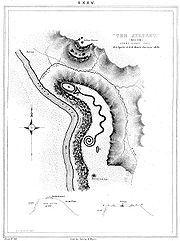 Squier and Davis's map from Ancient Monuments of the Mississippi Valley, published by the Smithsonian Institution Press in 1848
Squier and Davis's map from Ancient Monuments of the Mississippi Valley, published by the Smithsonian Institution Press in 1848
Scholars currently think that the Fort Ancient culture (1000-1650 CE), an Ohio Valley-based, mound-building society, constructed Serpent Mound about 1070 CE. The Fort Ancient culture was influenced by the contemporary Mississippian culture society based along the mid-Mississippi River valley with its North American center at Cahokia (in present-day Illinois). The Mississippian culture had regional chiefdoms as far south as present-day Louisiana and Mississippi, as well as extending to western North Carolina and north to the Great Lakes area.
The Fort Ancient society, a late Woodland culture group, was named because they inhabited the ramparts of the large notched earthworks in Warren County, Ohio, commonly called "Fort Ancient". The earthwork had been built, however, by the early Hopewell culture (200 BCE-500 CE) at least 1,000 years prior to the arrival of the Fort Ancient culture. The Hopewell culture had abandoned the earthworks and disappeared long before the Fort Ancient peoples arose in the area.
In 1996 the team of Robert V. Fletcher and Terry L. Cameron (under the supervision of the Ohio Historical Society's Bradley T. Lepper) reopened a trench created by Frederic Ward Putnam of Harvard over 100 years before. They found a few pieces of charcoal in what was believed to be an undisturbed portion of the Serpent Mound. However, bioturbation, including burrowing animals, frost cracks, etc., can reverse the structural timeline of an earthen mound such as Serpent Mound. It can shift carbon left by a later culture on the surface to areas deep within the structure, making the earthwork appear younger.
When the team conducted carbon dating studies on the charcoal pieces, two yielded a date of ca. 1070 CE, with the third piece dating to the Late Archaic period some two thousand years earlier, specifically 2920+/-65 years BP (before the present). The third date, ca. 2900 BP, was recovered from a core sample below cultural modification level. The first two dates place the Serpent Mound within the realm of the Fort Ancient culture. The third dates the mound back to very early Adena culture or before.[7]
The Fort Ancient people could have been the builders of the Serpent Mound. Alternatively, they may have refurbished the earthwork for their own use in the same way that people today fix up old houses to make them suitable for occupation again. The rattlesnake is significant as a symbol in the Mississippian culture, which would help explain the image of the mound. But there is no sign or indication of a rattle.[7]
If this mound was built by the Fort Ancient people, it was uncharacteristic for that group. For example, the mound does not contain artifacts, although, like the Adena people, the Fort Ancient culture typically buried many artifacts in its mounds. In another difference, the Fort Ancient people did not usually bury their dead in the manner of the burials found in proximity to the effigy.[7]
One of the only other effigy mounds in Ohio, the Alligator Effigy Mound in Granville, was carbon dated to the Fort Ancient period.
Purpose
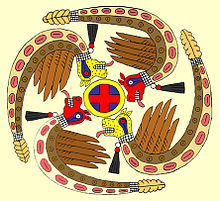 Uktena design from a shell engraving found at the Spiro Site in Oklahoma
Uktena design from a shell engraving found at the Spiro Site in Oklahoma
The Serpent Mound is the largest effigy mound in the world. While there are several burial mounds around the Serpent mound site, the Serpent site does not contain any human remains. It was not constructed for burial purposes.
The Cherokee relate the legend of the Uktena, a large serpent with supernatural appearance and power. The existence of the legend attests to the importance of the figure. Researchers have speculated that perhaps ancient native people created large totemic shrines that were built on platforms made of earth and stone. Such an effigy could have been destroyed by war or changes among inheriting cultures, with the result that only the platform (the mound) was left.[citation needed]
Astronomical significance
In 1987 Clark and Marjorie Hardman published their finding that the oval-to-head area of the serpent is aligned to the summer solstice sunset.[8] [9] William F. Romain has suggested an array of lunar alignments based on the curves in the effigy's body. Fletcher and Cameron argued convincingly for the Serpent Mound's coils being aligned to the two solstice and two equinox events each year. If the Serpent Mound were designed to sight both solar and lunar arrays, it would be significant as the consolidation of astronomical knowledge into a single symbol. The head of the serpent is aligned to the summer solstice sunset and the coils also may point to the winter solstice sunrise and the equinox sunrise.[10]
If 1070 CE is accurate as the construction year, building the mound could theoretically have been influenced by two astronomical events: the light from the supernova that created the Crab Nebula in 1054, and the appearance of Halley's Comet in 1066.[citation needed] The supernova light would have been visible for two weeks after it first reached earth, even during the day. The Halley's Comet's tail has always appeared as a long, straight line and does not resemble the curves of the Serpent Mound. Halley's comet appears every 76 years. Numerous other supernovas may have occurred over the centuries that span the possible construction dates of the effigy. However spectacular, the light from the Crab Nebula would not have inspired the particular design of the Serpent Mound.
The Serpent Mound may have been designed in accord with the pattern of stars composing the constellation Draco. The star pattern of the constellation Draco fits with fair precision to the Serpent Mound, with the ancient Pole Star, Thuban (α Draconis), at its geographical center within the first of seven coils from the head. The fact that the body of Serpent Mound follows the pattern of Draco may support various theses. Putnam's 1865 refurbishment of the earthwork could have been correctly accomplished in that a comparison of Romain's or Fletcher and Cameron's maps from the 1980s show how the margins of the Serpent align with great accuracy to a large portion of Draco. Some researchers date the earthwork to around 5,000 years ago, based on the position of Draco, through the backward motion of precessionary circle of the ecliptic when Thuban was the Pole Star. Alignment of the effigy to the Pole Star at that position also shows how true north may have been found. This was not known until 1987 because lodestone and modern compasses give incorrect readings at the site.[11]
Cryptoexplosion Structure
 Shatter cones associated with the Serpent Mound cryptoexplosion structure. Scale in mm.
Shatter cones associated with the Serpent Mound cryptoexplosion structure. Scale in mm.
The mound is located on a plateau with a unique cryptoexplosion structure that contains faulted and folded bedrock, usually produced either by a meteorite or a volcanic explosion.
"Determining exactly what formed the Serpent Mound Cryptoexplosion Structure is a problem that geologists continue to debate. Two main solutions have been offered. Some geologists think the structure is a meteorite or asteroid crater. Others suggest that the structure was caused by forces from inside the earth, probably an explosive eruption of gases derived from a deep magma source in the basement rocks."[12]
This is one of the few places in North America where such an occurrence is seen. While some scholars speculate that prehistoric Native Americans may have placed the mound in relation to this geological anomaly, others think there was nothing visible at ground level that would have captured their attention.
In 2003 geologists from Ohio State government and the University of Glasgow (Scotland) concluded that a meteorite strike was responsible for the formation. They had studied core samples collected at the site in the 1970s. Further analyses of the rock core samples indicated the meteorite impact occurred during the Permian Period, about 248 to 286 million years ago.[13]
Recent history
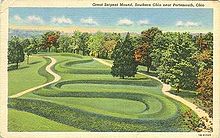 Serpent Mound postcard
Serpent Mound postcard
The Serpent Mound was first mapped by Euro-Americans as early as 1815. In 1846 it was surveyed for the Smithsonian Institution by two Chillicothe men, Ephraim G. Squier and Edwin Hamilton Davis. Their book Ancient Monuments of the Mississippi Valley (1848), published by the Smithsonian, included a detailed description and map of the serpent mound. Because they found large trees at the site, it is believed it was hidden by natural woodland for much of the time.
Preservation
Ancient Monuments of the Mississippi Valley fascinated many across the country, including Frederic Ward Putnam of the Peabody Museum of Archaeology and Ethnology at Harvard University. Putnam spent much of his career lecturing and publishing on the Ohio mounds, specifically the Serpent Mound. When he visited the Midwest in 1885, he found that plowing and development were destroying many of the mounds. In 1886, with help from a group of women in Boston, Putnam raised funds to purchase 60 acres (240,000 m2) at the Serpent Mound site for preservation. The purchase also contained three conical mounds, a village site and a burial place.[14] Serpent Mound is listed as a "Great Wonder Of the Ancient World" by National Geographic Magazine.[15]
Originally purchased on behalf of the Trustees of the Peabody Museum, in 1900 the land and its ownership were granted to the Ohio State Archaeological and Historical Society (a predecessor of the present Ohio Historical Society.) It became the first state park in the United States.
The Ohio Historical Society designated the Arc of Appalachia Preserves system, a project of Highlands Sanctuary, Inc., as the managing agency of Serpent Mound [16][17][10]
Excavation
After raising sufficient funds, in 1886 Putnam returned to the same site. He worked for four years excavating the contents and burial sequences of both the Serpent Mound and two nearby conical mounds. After his work was completed and his findings documented, Putnam worked on restoring the mounds to their original state.
Serpent Mound Museum
Main article: Ohio Historical SocietyIn 1901 the Ohio Historical Society hired engineer Clinton Cowan to survey newly acquired lands. Cowan created a 56 by 72-inch (1,800 mm) map that depicted the outline of the Serpent Mound in relation to nearby landmarks, such as rivers. Cowan also made specific geographical surveys of the area, and he discovered the unique cryptoexplosion structure on which the mound is based. He found that the mound is at the convergence of three distinctly different soil types. Cowan's information, in conjunction with Putnam's archaeological discoveries, has been the basis for all modern investigations of the Serpent Mound.
In 1967, the Ohio Historical Society opened the Serpent Mound Museum, built near the mound. A pathway was constructed around the base of the mound to help visitors. The museum features exhibits that include interpretations of the effigy's form, description of the processes of constructing the mound, the geographical history of the area, and an exhibit on the Adena culture, historically credited as the creators of the mound.
Serpent Mound State Memorial is currently being operated on behalf of the Ohio Historical Society by the Arc of Appalachia Preserve System. It is a non-profit organization specializing in the preservation and protection of native biodiversity and prehistoric aboriginal sites in southern Ohio.
See also
- Mound builder (people)
- Hopewell Culture National Historical Park
- Indian Mounds Park
- Crooks mound
- Spiro Mounds
- Glades culture
- Nazca Lines
- Cahokia
References
- ^ "National Register Information System". National Register of Historic Places. National Park Service. 2007-01-23. http://nrhp.focus.nps.gov/natreg/docs/All_Data.html.
- ^ Glotzhober and Lepper, ‘’Serpent Mound: Ohio’s Enigmatic Effigy Mound’’, Ohio Historical Society, Columbus, Ohio, 1994, p. 3
- ^ a b c Jessica E. Saraceni, "Redating Serpent Mound", Archaeology, 49(6), Nov/Dec 1996, accessed 8 Dec 2008
- ^ "Serpent Mound",http://www.mnsu.edu/emuseum/archaeology/sites/northamerica/serpent.html
- ^ http://www.mnsu.edu/emuseum/archaeology/sites/northamerica/serpent.html
- ^ Hamilton,Ross, The Mystery of the Serpent Mound, 2001
- ^ a b c "Serpent Mound: A Fort Ancient Icon?", Midcontinental Journal of Archaeology, Vol. 21, No.1, University of Iowa, 1996
- ^ Clark and Marjorie Hardman, Ohio Archaeologist 37(3):34-40 (1987)
- ^ Glotzhober and Lepper, ‘’Serpent Mound: Ohio’s Enigmatic Effigy Mound’’, Ohio Historical Society, Columbus, Ohio, 1994 p. 11
- ^ a b "Serpent Mound". Ohio Historical Society. http://ohsweb.ohiohistory.org/places/sw16/index.shtml. Retrieved 2011-03-05.
- ^ Hamilton, Ross, The Mystery of the Serpent Mound, 2001
- ^ Glotzhober, Robert C. and Bradley T. Lepper, Serpent Mound: Ohio's Enigmatic Effigy Mound, Columbus, Ohio: Ohio Historical Society, 1994
- ^ "UNIQUE SOUTH-CENTRAL OHIO ROCK STRUCTURE IS PROBABLY THE RESULT OF ANCIENT METEORITE STRIKING THE EARTH", Ohio Dept of Natural Resources, 12 Dec 2003, accessed 4 Dec 2008
- ^ Ralph W. Dexter, "Contributions of Frederic Ward Putnam to Ohio Archaeology", The Ohio Journal of Science 65(3): 110, May, 1965
- ^ "Serpent Mound Recognized As Great Wonder Of Ancient World". NBC4I.com. http://www2.nbc4i.com/news/2010/nov/10/serpent-mound-ar-286661/. Retrieved 2011-03-21.
- ^ "Serpent_Mound_Visitors_Guide". http://www.highlandssanctuary.org/Serpent_Mound_Visitors_Guide.htm. Retrieved 2011-03-05.
- ^ "Spring 2010 Highlands Nature Sanctuary Protecting The Region’s Woodlands". http://www.ohiohillcountry.org/PDF/VoiceSpring2010.pdf. Retrieved 2011-03-05.
Further reading
- Fletcher, Robert V., Terry L. Cameron, Bradley T. Lepper, Dee Anne Wymer, and William Pickard, "Serpent Mound: A Fort Ancient Icon?", Midcontinental Journal of Archaeology, Vol 21, No. 1, Spring 1996, University of Iowa.
- Squier, Ephraim G. and Edwin H. Davis, Ancient Monuments of the Mississippi Valley, Smithsonian Institution Press, Washington D.C., 1998. Reprint of 1848 edition with a new introduction by David J. Meltzer.
- Woodward, Susan L. and Jerry N. McDonald, Indian Mounds of the Middle Ohio Valley, Blacksburg, Virginia: The McDonald & Woodward Publishing Company, 1986
External links
- [1] "Great Serpent Mound"
- "Serpent Mound State Memorial", Ohio State
- "Hopewell Culture National Historical Park", National Park Service
- Ohio History Teachers - Field Trips: Serpent Mound
- "Archaeological Sites: Serpent Mound", Minnesota State University Mankato
- "Serpent Mound", The Ohio Historical Society
- Ohio State Archaeological and Historical Society
- Scientists try to unlock Serpent Mound secrets
 Fort Ancient culture
Fort Ancient cultureAnderson Focus 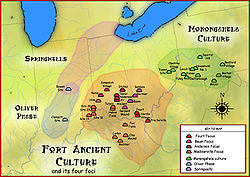
Baum Focus Alligator Effigy Mound · Baldwin Site · Baum Site · Gartner Site · Serpent MoundFeurt Focus Buffalo Indian Village Site · Feurt Mounds and Village Site · Hardin Village Site · Leo Petroglyph · Hobson SiteMadisonville Focus Buckner Site · Clay Mound · Cleek-McCabe Site · Clover Site · Fox Farm Site · Hahns Field Site · Larkin Site · Lower Shawneetown · Madisonville Site · Ronald Watson Gravel Site · Sand Ridge Site · Turpin SiteRelated topics · Bone Stone Graves · Bone Mound II · Cole culture · Mississippian culture · Monongahela culture · Oliver Phase · Oneota · Owasco culture · Springwells Phase ·U.S. National Register of Historic Places Topics Lists by states Alabama • Alaska • Arizona • Arkansas • California • Colorado • Connecticut • Delaware • Florida • Georgia • Hawaii • Idaho • Illinois • Indiana • Iowa • Kansas • Kentucky • Louisiana • Maine • Maryland • Massachusetts • Michigan • Minnesota • Mississippi • Missouri • Montana • Nebraska • Nevada • New Hampshire • New Jersey • New Mexico • New York • North Carolina • North Dakota • Ohio • Oklahoma • Oregon • Pennsylvania • Rhode Island • South Carolina • South Dakota • Tennessee • Texas • Utah • Vermont • Virginia • Washington • West Virginia • Wisconsin • WyomingLists by territories Lists by associated states Other Categories:- Fort Ancient culture
- Archaeological sites in Ohio
- Pre-state history of Ohio
- Museums in Adams County, Ohio
- National Historic Landmarks in Ohio
- Archaeology museums in the United States
- Ohio Historical Society
- History museums in Ohio
- Snakes
- Protected areas of Adams County, Ohio
- Parks in Ohio
Wikimedia Foundation. 2010.

